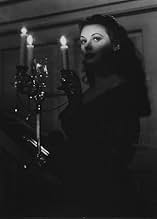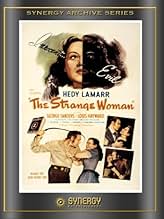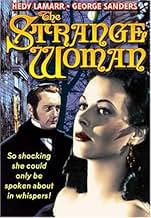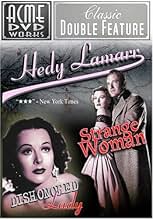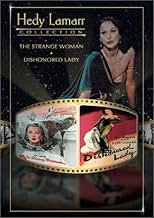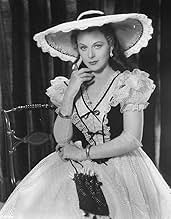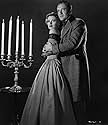IMDb रेटिंग
6.5/10
2.7 हज़ार
आपकी रेटिंग
1820 के दशक में न्यू इंग्लैंड की एक सुंदर लेकिन गरीब और चालाक जेनी हैगर अमीर बूढ़े आदमी ईसैया पोस्टर से शादी करती है लेकिन वो उसके बेटे और उसके कंपनी फोरमैन को भी बहकाती है.1820 के दशक में न्यू इंग्लैंड की एक सुंदर लेकिन गरीब और चालाक जेनी हैगर अमीर बूढ़े आदमी ईसैया पोस्टर से शादी करती है लेकिन वो उसके बेटे और उसके कंपनी फोरमैन को भी बहकाती है.1820 के दशक में न्यू इंग्लैंड की एक सुंदर लेकिन गरीब और चालाक जेनी हैगर अमीर बूढ़े आदमी ईसैया पोस्टर से शादी करती है लेकिन वो उसके बेटे और उसके कंपनी फोरमैन को भी बहकाती है.
Ed Agresti
- Congregation Member
- (बिना क्रेडिट के)
John Alban
- Congregation Member
- (बिना क्रेडिट के)
Fred Aldrich
- Sailor in Saloon
- (बिना क्रेडिट के)
Jessie Arnold
- Mrs. Thatcher
- (बिना क्रेडिट के)
Frank Baker
- Congregation Member
- (बिना क्रेडिट के)
Edward Biby
- Mr. Partridge
- (बिना क्रेडिट के)
फ़ीचर्ड समीक्षाएं
An obscure film which, because of surprising creative touches in directing, acting and editing, should be shown more often: more than a potboiler, more than a "women's picture" that did not happen to star Bette Davis or Joan Crawford, it offers an engaging story, characters of substance and - except for a convenient and contrived ending - an honest portrayal of people caught in a web of circumstances and emotions they cannot control. Aside from the glitter and sweep, it has more similarities to than differences from "Gone With the Wind."
This may be Hedy Lamarr's most challenging role, and she acquits herself quite well. George Sanders appears infrequently as a sympathetic character, but even he is victimized by the Scarlett O'Hara-like wiles of Hedy. That both of these performers have accents that are not suggestive of born-and-bred Maine residents should not constitute more than a minor annoyance. The picture has more than enough offsetting merits.
This may be Hedy Lamarr's most challenging role, and she acquits herself quite well. George Sanders appears infrequently as a sympathetic character, but even he is victimized by the Scarlett O'Hara-like wiles of Hedy. That both of these performers have accents that are not suggestive of born-and-bred Maine residents should not constitute more than a minor annoyance. The picture has more than enough offsetting merits.
An 1820's vixen climbs her way maliciously up the social ladder.
The movie's got the gloss and the casting of a top studio production, maybe TCF. But it's not. Instead, the film is an independent production with Lamarr as a co-producer. I mention this because the result looks tailor-made for a Lamarr career move; at the same time, she does manage to prove she's more than just Hollywood's perfect face. Here, her conniving little vixen (Jenny) transits a number of emotional stages and male victims in fairly convincing style. However, unless I missed something, Jenny's inner guile fails to show up in any of the many close-ups. As a result, Jenny's deceit remains mainly in the script—the one performance flaw.
The movie itself is an atmospheric potboiler, thanks to stylist Edgar Ulmer and art director Remisoff. The scenes may remain stage-bound, but the overall effect is compelling, a triumph of b&w expressiveness. Note too how the scenes get steadily darker as the film progresses and Jenny gets closer to the expected reckoning. Even when the screenplay meanders, which does slow things down, the visuals remain smoothly engaging. Then too, the logging camp setting should have been rethought. The sophisticated Sanders is simply not an outdoor type. Still, wonder of wonders, two of cinema's favorite cerebral baddies, Sanders and Brooke, get sympathetic roles, for a change. Actually, I expected Sanders to break into a cynical sneer at any moment, and maybe Brooke to revert to type with an icy glare. Anyway, it is an interesting cast, down to Hayward as the weakling Ephraim and little Jo Ann Marlowe as the meanest girl since Patty McCormack's Bad Seed (1956).
I don't know if the film resulted in the kind of career break Lamarr was likely looking for, but it remains an entertaining morality tale, despite a spotty script and stage-bound settings.
The movie's got the gloss and the casting of a top studio production, maybe TCF. But it's not. Instead, the film is an independent production with Lamarr as a co-producer. I mention this because the result looks tailor-made for a Lamarr career move; at the same time, she does manage to prove she's more than just Hollywood's perfect face. Here, her conniving little vixen (Jenny) transits a number of emotional stages and male victims in fairly convincing style. However, unless I missed something, Jenny's inner guile fails to show up in any of the many close-ups. As a result, Jenny's deceit remains mainly in the script—the one performance flaw.
The movie itself is an atmospheric potboiler, thanks to stylist Edgar Ulmer and art director Remisoff. The scenes may remain stage-bound, but the overall effect is compelling, a triumph of b&w expressiveness. Note too how the scenes get steadily darker as the film progresses and Jenny gets closer to the expected reckoning. Even when the screenplay meanders, which does slow things down, the visuals remain smoothly engaging. Then too, the logging camp setting should have been rethought. The sophisticated Sanders is simply not an outdoor type. Still, wonder of wonders, two of cinema's favorite cerebral baddies, Sanders and Brooke, get sympathetic roles, for a change. Actually, I expected Sanders to break into a cynical sneer at any moment, and maybe Brooke to revert to type with an icy glare. Anyway, it is an interesting cast, down to Hayward as the weakling Ephraim and little Jo Ann Marlowe as the meanest girl since Patty McCormack's Bad Seed (1956).
I don't know if the film resulted in the kind of career break Lamarr was likely looking for, but it remains an entertaining morality tale, despite a spotty script and stage-bound settings.
For a generation hooked on special effects, and mostly shoddy updates of very old film cliches, 'Strange Woman' must seem like a very dated movie. Of course, that largely depends on generational film tastes. A good story; good if sometimes uneven performances, and of course Hedy Lamarr; one of Hollywood's best kept secrets. Poor Hedy usually got the short end of the stick, as most of the critical acclaim went to very over-rated actresses, who were not nearly as beautiful as Hedy. Critics could never get past her phenomenal beauty, and more often rewarded Bergman, Turner, Davis, and Crawford, because they looked like ordinary everyday people. Oh! the simple minded, one-dimensional critics who imposed their bland tastes on a public, that just craved good entertainment. Hedy as Jenny Hager represents a daring stretch for Hedy; and she delivers a somewhat hammy, but nevertheless engaging performance. George Sanders is excellent as usual, in one of his lesser roles, and the cinematography is first rate. This is a melodramatic melodrama folks! It represents a bygone era in movie-making; when movies were made to entertain, sometimes most effectively in black and white, very often with modest budgets, and without mindboggling effects, extremely loud soundtracks. This movie deserves a 7/10.
Hedy Lamarr once said that the key to appearing beautiful is 'to stand still and look stupid', but here she proves she could act when required to. As the daughter of a drunk, Jenny has ambitions to rise in the world and become beautiful, using her wiles to subdue and bewitch men into doing her bidding. With a rich and older husband with a weak and easily led son, you can see where this is going, and with people like George Sanders and Louis Hayward supporting her in the cast, Hedy shines in the title role.
A beautifully shot, tightly written film which may have been low budget but has a definite sheen of polish.
A beautifully shot, tightly written film which may have been low budget but has a definite sheen of polish.
Hedy Lamarr and Egar G. Ulmer. OK. It really did happen, improbable as the pairing seems.
She is very convincing as the daughter of a drunk who wants to dominate men and the society that squashed her when she was a child. It seems to me that her father speaks with a Scottish burr and that she does very briefly. The story might better have been changed so that he was an immigrant whose accent would be more consistent with th4e luscious Ms. Lamarr's own.
Nevertheless, it is atmospheric and very troubling. She marries an older man and immediately starts out in pursuit of his son. She gets the son and throws him over (a bit improbably) for Gweorge Sanders, wearing mutton chop sideburns here.
It's not Ulmer'best -- that might be his "Hamlet"pdate "Strange Illusion." But it is very good and it is one of the best performances ever given by Ms. Lamarr.
She is very convincing as the daughter of a drunk who wants to dominate men and the society that squashed her when she was a child. It seems to me that her father speaks with a Scottish burr and that she does very briefly. The story might better have been changed so that he was an immigrant whose accent would be more consistent with th4e luscious Ms. Lamarr's own.
Nevertheless, it is atmospheric and very troubling. She marries an older man and immediately starts out in pursuit of his son. She gets the son and throws him over (a bit improbably) for Gweorge Sanders, wearing mutton chop sideburns here.
It's not Ulmer'best -- that might be his "Hamlet"pdate "Strange Illusion." But it is very good and it is one of the best performances ever given by Ms. Lamarr.
क्या आपको पता है
- ट्रिवियाExecutive producer Hunt Stromberg declared his dissatisfaction with the original opening sequence of Edgar G. Ulmer's own daughter Arianne Ulmer, who played the young Jenny; she purportedly was not nasty enough. So he and Hedy Lamarr enlisted Douglas Sirk to reshoot the scenes using Jo Ann Marlowe, who had appeared in Sirk's A Scandal in Paris (1946) earlier that year, and who also had featured as Joan Crawford's daughter Kay in Michael Curtiz' Mildred Pierce (1945).
- गूफ़Ephraim paints "Nöel" rather than the correct "Noël".
People often make spelling mistakes, especially where diacritical marks are concerned.
- भाव
Lena Tempest: Honey, listen, with your looks you don't have to worry. You can get the youngest and best-looking man on the pier.
Jenny Hager: I don't want the youngest. I want the richest.
- इसके अलावा अन्य वर्जनThe Strange Woman (1946). Restoration Produced by Jeff Joseph/SabuCat. Digital scan by Film & Video Transfer, Chatsworth, CA. Cineaste Restoration - Thad Komorowski.. Final Conforming & Cleanup by The Finishing Touch. The Strange Woman (Restored Version) copyright 2020 Jeff Joseph/SabuCat.
- कनेक्शनFeatured in Edgar G. Ulmer: The Man Off-Screen (2004)
- साउंडट्रैकWhat Can You Do with a Drunken Sailor?
Traditional
Early 19th Century sea chanty
[Heard in tavern]
टॉप पसंद
रेटिंग देने के लिए साइन-इन करें और वैयक्तिकृत सुझावों के लिए वॉचलिस्ट करें
- How long is The Strange Woman?Alexa द्वारा संचालित
विवरण
- रिलीज़ की तारीख़
- कंट्री ऑफ़ ओरिजिन
- आधिकारिक साइटें
- भाषा
- इस रूप में भी जाना जाता है
- Flor de insidia
- फ़िल्माने की जगहें
- उत्पादन कंपनियां
- IMDbPro पर और कंपनी क्रेडिट देखें
- चलने की अवधि
- 1 घं 40 मि(100 min)
- रंग
- पक्ष अनुपात
- 1.37 : 1
इस पेज में योगदान दें
किसी बदलाव का सुझाव दें या अनुपलब्ध कॉन्टेंट जोड़ें

